For your dog, itchy paws can be quite distressing. And listening to your dog lick and chew at his or her feet isn’t that pleasant for you either. Integrative veterinarian Dr. Julie Buzby discusses five reasons a dog may have itchy paws then gives six ideas for at-home remedies. Plus, she discusses when you should make a vet appointment and how your vet can help give your dog some itchy paw relief.
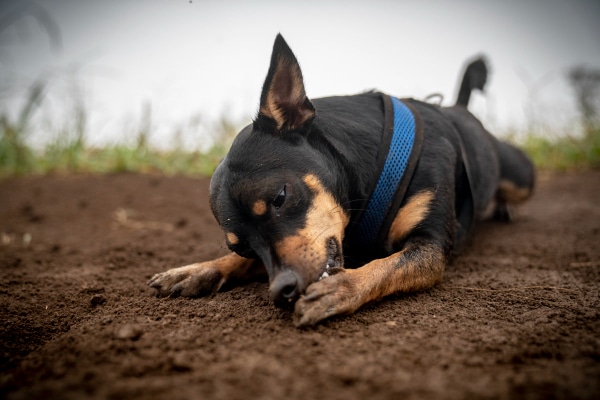
Is the sound of your dog licking his paws keeping you up at night? Does it seem like your dog spends more time chewing her feet than her toys? When you ask your dog to “shake” do you find yourself holding a saliva-soaked paw?
If you answered “yes” to any of those questions, your dog may have itchy paws.
5 reasons for your dog’s itchy paws
If this news comes as a surprise to you, don’t feel bad. It tends to be pretty obvious when other parts of your dog’s body are itchy because your dog scratches with a foot or rubs against the ground. On the other hand—or paw—the symptoms of itchy paws can be a bit more subtle. Keep an eye out for:
- Licking and chewing paws
- Discoloration of the fur on your dog’s paws
- Paws that are red and irritated
- Foot pad cracks or dryness
- Limping
- Abnormal paw odor
- Wet spots on your carpet or sheets from the obsessive paw licking
Notice whether your dog seems to be concentrating on one foot or switching between multiple feet. Plus, take note of any other symptoms your dog is showing. This information can help distinguish between the five causes of itchy paws in dogs that we are about to discuss.
#1: Allergies, allergies, allergies
It isn’t a mistake that I wrote allergies three times. This is by far the most common reason dogs are itchy and licking their paws, especially if all four feet are involved.
Dogs can have different types of allergies just like people can. If you see your dog itch only part of the year (like summer or spring), he or she could have environmental allergies. However, if your dog is itchy year-round or is also experiencing some vomiting and diarrhea, he or she could be suffering from food allergies.
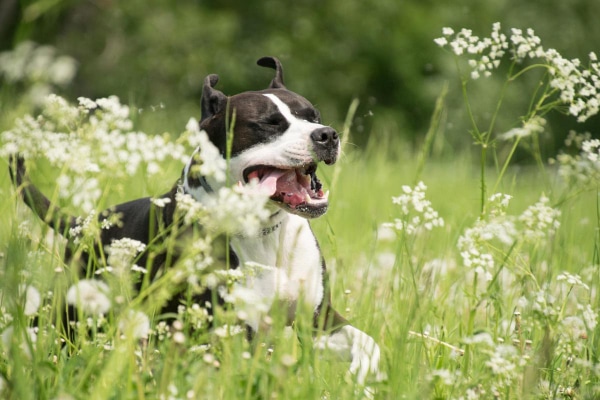
To complicate matters, some dogs have food allergies plus environmental allergies, which can make them somewhat itchy year round but worse certain times of the year. Or a dog might have environmental allergies to things that are present year round (like dust mites). It is also worth noting that some dogs are allergic to flea saliva. However, flea allergies are less likely to cause itchy feet than food allergies or environmental allergies.
If your dog has allergies, you might notice symptoms such as:
- Red and itchy paws
- Ear infections (i.e. otitis in dogs)
- Itching or scratching other parts of the body
- Dry, flaky, red, or irritated skin
- Red, swollen eyes
- Eye discharge
- Nasal discharge
- Sneezing
If you notice these symptoms and suspect your dog has allergies, please consult your veterinarian. He or she can help you find the allergy management solutions that are right for your dog.
#2: Bacterial skin infections
Licking and chewing the paws because of an allergy can also set up the perfect environment for a bacterial skin infection (i.e. pyoderma in dogs). So can parasites or hormonal disorders. And sometimes no one can find a cause.
As a result of the infection, the dog may have red and itchy paws which look irritated. Sometimes the paws also become swollen and painful or develop an odd odor. The pain and itching may cause the dog to lick and chew at the paws even more, further worsening the irritation.
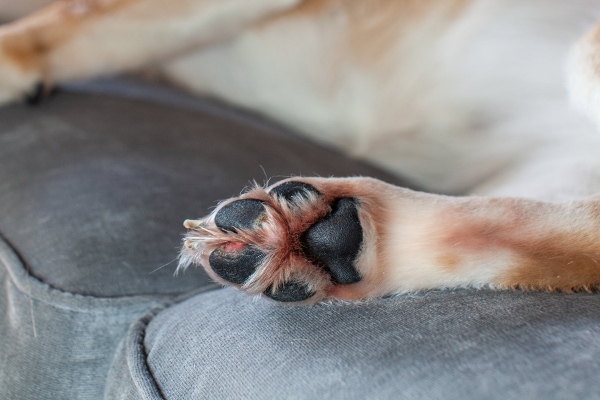
If you suspect your dog has a bacterial infection on his or her feet, please make an appointment with your veterinarian. Skin infections can progress quickly so it is best to start treatment as soon as possible.
#3: Fungal skin infections
Along the same lines, dogs who are itchy and licking their paws due to allergies can end up with a dog paw yeast infection. The same is true of other situations that lead to increased moisture on your dog’s skin. For this reason, dogs who go swimming frequently or live in wet environments are prone to developing yeast infections of their paws.
One of the first signs that many owners notice when it comes to yeast infections is the smell. These infections smell musty or like moldy cheese. Also, the paw might have a moist appearance and be irritated, red, and itchy.
Yeast infections are most likely to develop between the toes or paw pads. These small tight areas don’t get as much air flow as other parts of the dog’s body so they tend to trap moisture. The problem is compounded when a dog has hairy feet because the wet hair can hold moisture close to the skin.
Contact your veterinarian if you suspect your dog has a yeast infection so your dog can get some relief. Your vet can also discuss ways to prevent yeast infections like keeping your dog’s paw hair trimmed and drying your dog off well after swimming or bathing.
#4: Dry, irritated, or cracked paw pads
Sometimes you might encounter a situation where your dog has itchy paws after a walk but was perfectly normal before. This can happen for a few reasons:
- Walking through sand can dry out your dog’s feet.
- Hot cement may burn your dog’s paw pads which leads to pain, irritation, and itching. (Learn more from Washington State University College of Veterinary Medicine’s article on protecting your pet’s feet from heat.)
- Ice melt products could potentially irritate your dog’s paw pads after a winter walk.
Any of these scenarios can also cause your dog’s paw pads to crack as well. If you have ever had your hands become chapped and cracked, you know this can be both itchy and painful. The same is true for your dog’s feet.
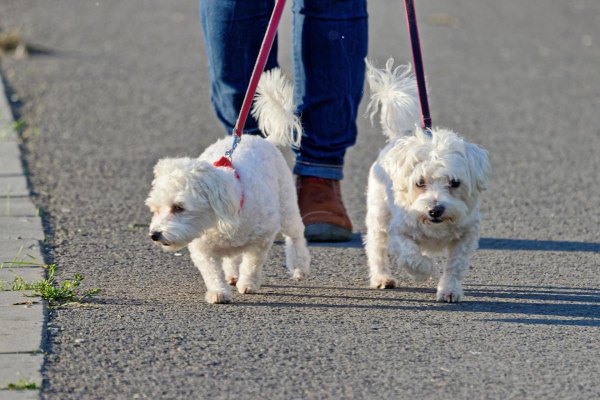
To avoid these issues, consider using PawZ Dog boots to protect your dog’s feet. These rubber boots do a great job of keeping feet safe while still allowing your dog to feel and grip the ground when walking. This isn’t the case with other dog boots, which is why PawZ are the only ones I recommend. You can also try walking your dog in the grass instead of on the cement, and washing your dog’s paws off when coming in from outside.
#5: Grass awns or other foreign bodies
An important consideration, especially if only one foot is affected and the licking and chewing started suddenly, is a foreign object stuck in the foot.
Sometimes the seeds, heads, or awns of plants that grow in some geographical areas are the culprit. The worst one is foxtails in dogs. These weeds have a seed head that falls off as the plant begins to dry and die. Foxtail seeds are V-shaped and have a very sharp, pointy tip. Because they are shaped like an arrow, they can become easily embedded in your dog’s foot or other body parts.
Foxtails or other foreign objects can cause swelling, infection, and irritation of the affected paw. The dog may also begin limping on that leg. These foreign bodies can even migrate further into your dog’s body. It is important that they are taken seriously.
If your dog has the potential to encounter foxtails, grass awns, or burrs, it is important to carefully check your dog for them as part of your regular tip-to-tail dog wellness scan. Immediately remove any plant material you find in your dog’s fur.
If your dog has a foxtail or other grass awn in his or her foot, you can try using Epsom salts to draw it out. Soak your dog’s foot in water with Epsom salts for 10 to 15 minutes while ensuring that he or she doesn’t try to drink the soak water. If this does not draw out the whole grass awn, please contact your veterinarian to have him or her safely remove the whole seed head. Also, call your vet if you suspect that a grass awn has migrated into your dog’s paw.
At-home remedies for your dog’s itchy paws
Seeing (and hearing) you dog lick and chew his or her feet all day and night long because of any of the problems we just discussed can be difficult (and irritating!). So, let’s talk about some at-home ways to give your dog itchy paw relief.
#1: Benadryl
When dog parents suspect their pup has allergies, one of the first things they want to try is an over-the-counter anti-histamine. In most cases, it is okay to use Benadryl for a dog’s itchy paws.
However, there are a few things you need to know about using Benadryl for dogs. First of all, it is important to take a close look at the label before giving it to your dog. Sometimes children’s Benadryl can contain the artificial sweetener, xylitol, which is toxic for dogs. Also, diphenhydramine (the drug name for Benadryl) should be the only active ingredient. Combination products that contain Benadryl plus other drugs can be dangerous for your dog.
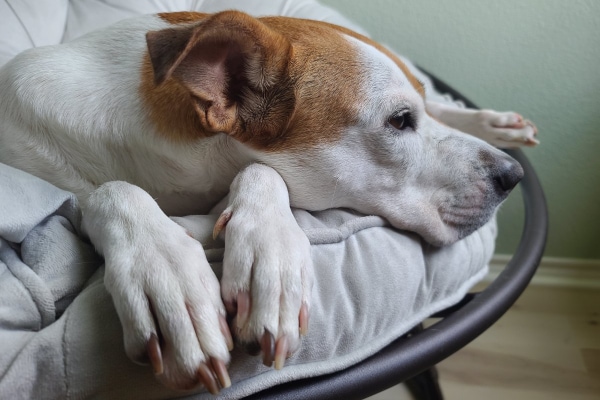
Additionally, Benadryl can interact with other medications. It also can have increased side effects for dogs who are pregnant, nursing, or have heart disease. So, you should consult your veterinarian before giving Benadryl to your dog, especially if they have one of these described conditions.
#2: Apple cider vinegar
You also can try applying a small amount of dilute apple cider vinegar to the itchy spot on your dog’s paw. The apple cider vinegar should be diluted 50/50 with water. This can be used as a spray or a soak for itchy dog paws.
#3: Bathing and wiping
If you suspect your dog has environmental allergies or his or her skin is irritated from contact with something in the environment, you could consider bathing your dog with a moisturizing or “allergy reducing” shampoo. The very act of giving the bath can remove surface allergens and the special shampoos can help soothe the skin. Along the same lines, wiping your dog’s paws off with baby wipes when he or she comes inside can also help remove irritants and allergens.
#4: Paw balms
If your dog has dry or cracked paw pads, a paw balm might be useful. Paw pad balms can help add moisture back into the dry paw pads, and some balms even have anti-inflammatory properties.
#5: Changing your dog’s diet
While many dogs with food allergies will require a prescription diet, sometimes feeding your dog an over-the-counter “sensitive skin,” “limited ingredient,” or “hypoallergenic” diet can be help reduce itching. Beware of grain-free diets, though, as they may be linked to dilated cardiomyopathy, a potentially fatal heart condition.
#6: Omega-3 fatty acid supplements
If the root of your dog’s problem is allergies or inflamed skin from an infection, omega-3 fatty acids supplements for dogs might be another great option. Omega-3s have amazing anti-inflammatory benefits and also help promote healthy skin and fur.
Veterinary remedies for your dog’s itchy paws
While a home remedy might work for mild cases of itchy paws, I do want to be clear that there are many situations where it is appropriate to seek veterinary care for your dog rather than attempting treatment at home. Contact your vet if:
- Your dog has a grass awn or other foreign material stuck in the paw
- Your dog is limping or obsessively licking and chewing at a paw
- The paw is red, painful, warm, irritated, odd smelling, or swollen
- You have been attempting to manage allergies at home but the dog is getting more itchy
- Your dog’s condition is worsening
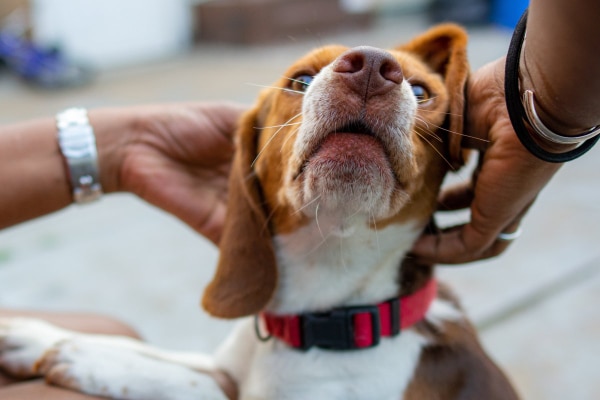
The veterinarian has many tools at his or her disposal to help your dog get itchy paw relief and heal quickly. Some of these options include:
- Anti-inflammatories to reduce pain and inflammation
- Antibiotics to treat bacterial skin infections
- Antifungals to address yeast infections
- Medicated shampoos or wipes for treatment and prevention of infections
- Allergy medication for dogs to reduce itching
- Removal of foreign material
- Hypoallergenic or novel protein (i.e. venison, bison, elk, etc.) veterinary prescription diets to manage food allergies
Work with your veterinarian
As you have gathered, there are a variety of reasons for a dog to have itchy paws. This also means that treatment isn’t one-size-fits all. The best way to get to the bottom of the problem and find the right remedies for your dog is to involve your veterinarian in the process. Hopefully, with a little help from your vet and some veterinary and at-home remedies, your dog’s paws will be less itchy in no time at all.
Why were your dog’s paws itchy and what worked best to give him or her some relief?
Please comment below.


My labradoodle has red feet that he likes to chew on, the vet told me it could be allergies by touching the lawn, I can’t not let him go outdoors, so I wonder 2 pairs of shoes might work?
Hi Dog owner,
I am sorry your boy is suffering with allergies. Boots may offer some relief, but I hate to cover a dog’s feet if I don’t have to. I highly recommend you consider scheduling a consultation with a veterinary dermatologist. They can offer guidance and even help narrow down the exact cause of your pup’s allergy problems. Hoping for clear answers and an easy solution. Best wishes to you and your sweet boy.
I just finished reading on internet about several remedies for itching feet, yeast & bacterial infections. Several essential oils, coconut oil & apple cider vinegar were recommended. That article led me into this “forum”. I’m going to start today, 1 or 2 at a time. There is a lot of good information out there to study & try. If I find a perfect cure I’ll write bk.
Hi there I was just curious about feeding your dogs boiled chicken everyday can it become unhealthy or an issue because that’s all I feed my dogs and occasionally with white rice
Hi NaNa,
This is a great question! Boiled chicken is very healthy but not nutritionally complete. Even with adding rice your pups are missing out on many essential vitamins and minerals. If you continue with only chicken for an extended period of time it is likely your dogs will start to develop issues related to their diet. There is a website called Balance.it that offers to help with creating a balanced home cooked meal plan for dogs. You can select the ingredients you want to use, and it lets you know how much to include and if other ingredients need to be added. Here is a link to the website: https://balance.it/recipes#
And here is another article that may offer some additional information: 14 Vegetables Dogs Can Eat (And May Just Love)
Wishing you and your dogs all the best!
i have a 2 year old labrador and he started to lose hair and itching 3 months ago, we took him to the vets and he was prescribed steroids which worked very well. recently he started again and i changed his biscuits and switched to home made meal and losing hair even straching stopped instantly.
the we bought grain free biscuits and he started again. i bought grain free wet food and started to give him wet food together with some grain free biscuits, losing hair stopped but he is viciously itching his paws, i believe this is some sort of dry skin issue but i just can’t be sure. he is not losing hair but he is vociously itching his paws and sometimes hos belly.
i am giving him some yoghurt as it has probiotics and fish oil but i don’t know what else to do. i just don’t want him to be on steroids as it is masking the problem, i just want to find out what the issue is.
anyone having similar issues, please help.
thank you
Hi Perihan,
I am sorry your young dog is having these ongoing issues with his paws itching. I suspect this is an allergy issue but cannot say for sure exactly what your boy is allergic to. The best way to narrow down the cause is to talk with a veterinary dermatologist. They can offer allergy testing if needed and provide guidance on how best to give your pup relief. There are also medications such as apoquel and cytopoint that help with inflammation that you may want to discuss with your vet. Hoping you can find the answers you need and wishing your sweet boy all the best.
I have a 4 year old Hound Dog. He’s been licking his paws and legs almost constantly. He has a spot on his nose that’s red and sore looking. We’re love in an apartment so the lawn area is the communal bathroom for all the dogs who love here. Doggy poop bags are provided but id say less than 10% of the dog owners use them. I’m sure it’s some kind of skin allergy or bacterial. What is recommended to use on his skin?
Hi Tonya,
I am sorry your pup is experiencing these problematic skin issues. Unfortunately, without knowing the cause or being able to examine him personally, I can’t offer specific recommendations. Your best bet is to schedule an exam with your vet and let them give you their expert opinion. They can let you know what diagnostics are needed to rule out the different types of allergies (contact, environmental, food, etc.) and offer treatment for an infection if one is present. Hoping you can find the best way to give your pup relief. Praying for healing and that this issue will be resolved completely.
I read anchovies could help skin issues. Anchovies in water (not any seasoned or oil and no salt added) or frozen. I could not find anything on line. I was happy when I found frozen anchovies at my local Asian market. My dog loves them. She is 30 lbs. I give 3 to 4 per day. Puppies need fewer anchovies than adult dogs, and small breeds can have 1-3 anchovies per day, while large ones can have up to five. Anchovies are not the same as sardines. When I looked for anchovies, sardines popped up also just fyi.
we found our 3 year old lab became allergic to his dog food. Lots of itching, toe and belly licking. We took him to the vet who gave us some medicated shampoo which really helped and then put him on a hydrolyzed diet. After 3 months on that diet we started adding food back in, one item at a time and discovered he’s allergic to chicken and bee,f so now I have to read labels. I’ve certainly noticed that chicken is in everything. I make my own dog treats for him now lol. He’s definitely got some environmental allergies, so we also wipe him down with a damp face cloth when we get back from our walks. Who knew!
Hi Dave,
Allergies can be so frustrating! I am sorry you are working your way through this difficult situation with your Lab. What a blessing the hydrolyzed diet is keeping the inflammation under control. Thank you for sharing your experience with our readers. Wishing you continued success and keep up the good work!
Hi,
Our 2 year old Morkie has severe allergies. We have tried everything (working with our Vet). She currently gets Apoquel and Cytopoint shots, but still scratches throughout the day. She had 5 separate ear infections, and multiple eye and paw infections (yeast each time). I clean her paws after every walk and clean her ears once a week with mild ear cleaning solution from vet. We also put her on bland food diet for 8 weeks to see if it’s a food allergy with no improvement. I don’t know what else to do and hate to see her in discomfort all the time 🥲. Any additional suggestions would be much appreciated.
Hi Brian,
I am sorry your young pup is struggling with chronic allergies. I understand how frustrating it can be when battling these ongoing issues. Without playing a personal role in your dog’s medical care, it is hard to make specific conclusions or recommendations. It may be a good time to consider asking for a consultation with a veterinary dermatologist. They can help narrow down the cause of her problems and might have ideas about new treatments or therapies that are available. Hoping you can get the answers you need to ensure your girl can continue living her best life. Praying for healing and relief.
hi I have a morkie with allergies and my name is also Brian. go figure.lol
Hi and good afternoon,
My 6 year old Chihuahua gets itchy paws each year around the end of summer and early fall, so I assume it is allergies or some type of fertilizer the condo association uses on our lawns.
Typically, I get a prescription for Apoquel from the veterinarian but they charge $250 -$300 for a “test” before having to pay for the medication itself.
Isn’t there something I can give my poor suffering buddy that doesn’t cost me $500 each year?
Please help and thank you so much,
Kelly (Koi)
Hi Kelly,
I am sorry your pup is dealing with these recurrent allergy issues each year. If the timing of these episodes is predictable, it may be an option to try an over-the-counter allergy medication and start giving it about a month prior to the expected allergy season. You would need to talk to you vet to determine which medication is best and what dosage to use. Also, you might want to consider scheduling a consultation with a veterinary dermatologist to get more information and go over all the possible treatments and therapies that are available. Hoing you can find a way to offer Koi relief and soften the blow to your finances. Wishing you both all the best!
I just wanted to say my 7 year old chihuahua has the same allergy. If you find a cheaper over the counter medicine that works please post it. I go broke every summer trying to help my little guy and he is still irritated most of the summer. It starts slow between June/July and then by August he can’t even go on a full walk. I usually have to carry him half way around the block. I wish there wasn’t so many products claiming to work that don’t do anything.
Dear Michael,
I am sorry your Chihuahua suffers from these severe allergy symptoms each year. Hoping you can find a way to offer him relief that does not put a strain on your finances. Wishing you and your sweet boy all the best.
If you have a Sam’s Club membership, check prices for pet medications at their pharmacy. Apoquel (not sure if I spelled it right) was a fraction of the cost for my mom compared to getting it from her vet’s office.
I have a 4 year old West Highland (my second). The first one died from bladder cancer and had issues with feet licking especially in the summer, We live in Florida. I notice our new pup is doing the same licking issue. I am wondering if I have a fungus in my yard (Rhizoctonia solani,) which is common in hot weather. My biggest concern is I think my first dog may have gotten the cancer because I was using Trimec to kill weeds. I subsequently found that this chemical can cause bladder cancer in terriers, Can I use a fungicide without concern following the directions (Scotts DIseaseEX) or do you feel that a lawn fungus is not the issue.
Hi Jon,
I am sorry for the loss of your Westie and understand your concern for your 4-year-old pup. While a lawn fungus could be the culprit of their itchy feet, it could also be so many other things. I looked up the active ingredient in Scotts DiseaseEX but was not familiar with it or how it could affect animals. Before treating your yard for an unknown issue, I would recommend having your vet do some more in-depth investigation with your dog. Don’t forget you can ask for a consultation with a veterinary dermatologist if needed. They would have more information about possible causes and ways to treat this problem. Hoping for answers and a clear path forward. Wishing you both the best of luck!
Eleven year old Shorkie ‘suddenly’ is chewing on a 4 paws. No fleas and no change in food. Only in our backyard with grass that doesn’t have anything sprayed on it. Our other dog is NOT doing the same this. This started about 3 weeks since groomer, so not there. Once to a dog park but 2 weeks ago. I’m at a loss to point to a source. He is a calm dog so not anxiety.
Hi Patti,
I agree this is very puzzling. I wish I had some great advice but without examining your pup myself it is hard to make specific conclusions. I think your best bet is to have your vet do a thorough evaluation and see if they can pinpoint a cause. Hoping for answers and a clear path forward. Best wishes to you and your senior guy.
Check for mites very hard to get rid of and there are invisible. This is how many dogs loose their hair and skin gets red from the itching. Not only that those mites invade your household and you if your health is not healthy. I’m saying this for it happen to me it was a horrible ordeal.
All of my dogs (4) except one have problems with chewing their paws. That one and another dog were the only two we had when we moved to this house. Neither showed signs of allergies before and my older one was 8 when we moved. His started at his paws shortly after moving in. This yard has a bunch of weeds that we tried many ways to get rid of. We accumulated three more dogs later and two of those would constantly go at their paws and after a couple of years so did the third. The oldest one passed away but we have tried many things to tackle the paw itching that I believe has to be coming from the weeds. We do apaquel and cytopoint injections which help minimize some of the itching and now we are trying aller-immunity chews and salmon oil along with apaquel wish us luck.
Hi Sue,
I am sorry you are battling this difficult situation with all of your dogs. Your pups are very lucky to have you advocating for their health and well-being and taking such big steps to try and bring resolution to this problem. Hoping you can find the best ways to continue offering relief and maintain their happiness and comfort. Bless you and keep up the good work!
Our 8 yo terrier mix has been suffering with irritated, extreme inflammation. She’s been to the vet 3 times in the last 6 weeks. The vet has given her an allergy injection twice in the last month. She was prescribed antifungal medication and antibiotics with no relief or improvements. The vet said she wouldn’t recommend an allergy test because it isn’t a guarantee. She also recommended a dermatologist. We’re stressed because I know she’s suffering. I just read about putting omega 3 in her food. Do you have any recommendations. We’re desperate.
Hi Orchid,
I understand your concern and frustration with these severe allergy symptoms in your pup. Your vet is correct that the blood test for allergies is not very accurate and can give false information. The gold standard in allergy testing is an intradermal skin test (just like they do with humans) which could be performed by a veterinary dermatologist. I do think referral to a specialist is probably the best option at this point. I know it will not be cheap, but you will end up saving money in the long run. It would be better to get a definitive diagnosis and treat it rather than to try and keep the symptoms at bay and never really attack the actual problem. Omega 3 supplements are great for skin, and I would recommend adding one to your dog’s regimen, but it will not resolve the problem. Here is an article with more information: Allergy Medicine for Dogs: 9 Solutions to Calm Your Dog’s Itch
I hope you will find the answers you need to ensure your sweet girl gets some relief. Wishing you the best of luck!
My white female Boxer is allergic to everything! I spent 18 months in misery with her trying to make it better. Apoquel worked for awhile but then seemed to lessen in its effectiveness after a couple of years.
Then we found Cytopoint! “It is a biological medication (a protein, not a chemical) that works like your dog’s own immune system to block the main protein that sends signals that trigger allergic itch” (quote from cytopoint.com).
Cytopoint is given as an injection in which dose is based upon dogs weight. It usually lasts between 4 to 8 weeks, our average is 6 weeks. So like clockwork every 6 weeks she gets the injection and has been itch free for going on 5 years now. It’s been amazing.
So when our newest addition, a male Boxer who just turned one last month, started in on his feet I knew just what to do. He is now also itch free and life is good.
Definitely worth asking your Vet about! I’m not affiliated with Cytopoint in any way other than a pet owner who gets it for her pup. I just so wish someone had told me about Cytopoint earlier. It came out in 2016 and it was late 2018 I believe before I became aware. So I make sure to spread the word when I see posts like this. 😊 Best Wishes!
Hi A. Kelly,
I just read your other reply you posted as well as this one. You give some great details on this treatment, and I love the specifics you mentioned. Thank you for being willing to share this much needed information with our readers. Cytopoint has been discussed in some of our other articles about itching and allergies but was not mentioned in this one since it is about home remedies. I am glad you brought up this topic and I am sure others will find it very helpful. Best wishes and take care!
Thank you. My dogs are miserable with sore paws. We have ordered paw balm and will bathe their toes in apple cider vinegar. If that does not work, we will go to the vet. This is such a helpful Blog, and it perfectly described our dogs’ symptoms.
Hi Petrina,
Thank you for the kind words. I am glad the article was helpful and offered some suggestions you could safely try at home. Hoping your sweet boy will get some relief soon. Best wishes to you both!
Extremely sensible advice, easy to comprehend and utilize ! My dog iis a mix with poodle and 12 years old . Although I am a retired nurse, we are struggling to help our dog with his itching, licking and repeated infections. After reading your article about the causes of licking his paws, I downloaded your Senior Dog Guide. I have another vet appt today & will share your suggestions. I will pursue a remedy so my dog can be healthy and happy.
Hi Denise,
Thank you for the kind words and positive feedback. Hoping you can partner with your vet to find a way to get your senior girl comfortable. Wishing you both the best for a happy future. ♥
Just wanted to say, thank you for posting Dr Buzby and the other pet parents.
My three year old good girl (have no idea what she is) just started licking her paws.
I thought it might be her dew claws (all feet) and took her to have them ground down but she’s still licking.
I am going to try everything posted here and hope something helps!
Hi Amy,
Glad you have found some helpful tips and things to try at home. Don’t hesitate to reach out to your vet for help as well. Wishing you the best of luck!
We have a beautiful female Dane 8 months old and she is constant work with allergies. First we put her on the purina sensitive skin Salmon for large breed puppies 2. eliminated all treats 3. filtered and bottled water only ( all for 30 days ) then we started adding one item a week and carefully monitored everything about her. her stools, her skin, her urine output. We were able to detect during this process, she could not be given any form of chicken, no filler no broth or no chicken by products. We also found out she could not tolerate any milk products ( milk bones ) She can not tolerate beef ( shocking ) No high fats.
She could not tolerate any high protein foods. We are down to one paw to monitor which we are carefully monitoring for fresh cut grass allergy, which we have to rub benadryl in whenever the lawn is cut. We are trying paw booties to see if she will leave them on and keeping her nails short to avoid the nails pushing into her paw pads when she runs.. This week we are staying calm and no changes because she just went into her first heat and home baked treats are being baked ( only flour, banana, pumpkin and applesauce ) No eggs again yet, eggs caused a severe allergic reaction ! Stay diligent and keep notes.
Hi Marie,
I am amazed at what an amazing job you have been doing managing all these allergy issues in your Dane puppy. Thank you for sharing your experience and offering this great advice to other readers. Hoping your sweet girl can stay on track. Wishing you both many happy years together and keep up the great work!
I have a Malti – poo that has been tested for allergies .her main allergy is to Grass. Of all things its terrible . She licks her paws to the point that they bleed. My vet has been giving her a shot monthly and she is on Apoquel this has helped very little. I am bathed her in a medicated bath daily now and it seems to help a little I have changed her diet and make her food now have tried almost everything you can think of .probiotics, different allergy medications but the licking is a bad habit that I think is more on the line of OCD . This sweet dog belonged to a customer of mine she walked in my shop about 7 years ago was crying and handed her to me, asked me to find her a home because she couldn’t take the problems she had . I am a dog groomer and was a vet tech for several years . I read everything I can find to help her .. She has to wear a basket muzzle now and I have booties I keep on her but the first chance she gets she will go after her feet . I am lost as to how to help her . It breaks my heart to have to make her wear a muzzle and booties but I don’t know how to stop this it has to be miserable for her . please any advice any new things that have come out to treat allergies I am open to trying its been 7 years everything works for a minute and then it stops working .
Hi Lore,
I am sorry your little pup is suffering from chronic allergies. Without playing a personal role in her medical care it is hard to make specific recommendations. If you are concerned about an OCD behavior, maybe you could discuss anti-anxiety medications with your vet? It is possible something like trazodone could help. Also, chronic inflammation from any source can lead to chronic pain. Another thing you can talk to your vet about trying would be pain medications like gabapentin. I hope you can find the best way to restore your sweet girl’s quality of life. Keeping you both in my thoughts. Bless you.
I’m in the same boat. I’ve spent so much money on various solutions. Short of allergy testing and shots. I can’t go there bc I can’t afford that.
Hi Fran,
Allergy testing may be the only way to get a specific diagnosis and then actually treat the problem instead of just managing the symptoms. I understand it is expensive, but it would probably save you a lot of money in the long run. Hoping you can find the right way to give your pup some relief.
Cytopoint is the answer you seek!
I have a white female Boxer who is allergic to everything. I spent a long 18 months bathing, soaking, researching, buying booties, going to vet, searching the internet for hours for anything new to try…it was exhausting and heart breaking.
After all that we decided to try Apoquel when the Vet suggested it. It worked ok for awhile but after a couple of years it seemed to lessen in its effectiveness. Also the potential side effects are atrocious and I hated that the whole time but was stuck.
Then, I forget where, but somewhere, Cyropoint came to our attention. Cytopoint is an injection that typically lasts for 4 to 8 weeks and usually goes into effect within 8 to 12 hours after injection given. My Boxer usually goes about 6 weeks before I start to see itchy behaviors returning. I just call the Vet and back we go. I also like the fact that Cytopoint is a biological med made up of a protein, not a chemical that may harm their health. It is said that Cytopoint works like a dog’s own immune system to block the main protein that sends signals that trigger allergic itch. Truly that is exactly what it seems to do and my pup’s anxiety goes away and calmness returns. As calm as a Boxer can be anyway 😆.
Definitely take a look at this injection if haven’t done so between date of this post and your original post. I can not say enough about how much it’s improved my pups quality of life as well as my sanity. Highly recommend to anyone who has a pup dealing with atopic dermatitis or a skin condition in general that results in frantic licking, biting and misery.
Hi A. Kelly,
This is great advice, and I couldn’t have said it better myself. Thank you for sharing your experience with our readers!
My dog is on grain free but still licking his feet all the time now they have tune pink
Hi Maureen,
I am sorry your pup is having issues with itchy feet. A grain free diet will only help if the cause of his problem is related to a grain allergy. There are so many other possible causes it would be hard to narrow them down without some investigation. I highly recommend you contact your vet and let them know about this issue.
I would take an allergy test mine came back with all kinds of allergies. Grass, flaxseed oil, canola oil, venison and too many to list
Also a few dogs developed a heart condition after being put on complete grain free so i added quinoa. Although no one can verify if its the removal of all grains or increase of kidney beans. I started making all her meals the itching isn’t completely gone yet but 80% better in 6 weeks
Hi….My 13 yo Pekingese, Mia, is constantly licking her front & back paws & back legs ; the fur there is now red almost dark brownish; pads on paws seem okay not red at all; Her tear stains are making the fur on her face red & most concerning to me is that her stools are the same rusty reddish! It doesn’t look like blood at all. I took her to a new Vet for her yearly this year & he just blew it off saying basically that she’s old, the ph in her saliva has changed, nothing to be done….but she’ is so uncomfortable & extremely restless at night especially.. She also has a painful Compressed Spinal condition (I took her back to her old vet clinic for that) & she was prescribed an
anti inflammatory med for that but the licking/red fur&stool situation has been going on way before that. Any idea why her stools would also be the rusty red color? Should I take her back to the Vet for that?
Any advice will be appreciated.
Thanks for reading this….Rose M.
Hi Rose,
I understand your concern for your senior pup and these strange new symptoms. Without examining your dog, myself, I can’t make specific conclusions or recommendations. I do think you may need to ask for more testing and see if your vet can investigate further. Has Mia had any blood work done recently? If she was acting normal and there were no issues other than the color change of her feces, I would not be as worried. But if Mia is uncomfortable and painful then something has to change. I hope you can find the answers you need to restore your sweet girl’s quality of life and ensure her health and well-being are maintained. Wishing you both the best as you navigate this unknown path.
Hi Dr. Buzby,
This article is so helpful! We have a 4 year old beagle who has been suffering from itchy paws for the past 9 months. We noticed growths on the top of her 2 front paws and even with allergy meds, steroids, powder for infection the vet gave us, the growths have now spread to all 4 paws and the bottom of her foot pads are inflamed. She tries to lick incessantly both on the top growths and underneath her pads. We also noticed she’s starting to limp a little.
We understand this could be allergies or a combo from the environment, but after several trips to the vet, we’re getting desperate. Any tips would be greatly appreciated!!!
Hi Drija,
I am so happy to hear that you found this article helpful. But, I am sorry that your Beagle has been experiencing itchy paws for so long. Skin issues are so frustrating for everyone (including owners, dogs, and the veterinarian). Sometimes it can be very difficult to diagnose what the underlying problem is. Any new updates on how she is doing now? Sending healing thoughts for your sweet girl. ♥
My Maltese for years has been licking and gnawing her pawis and I have taken her to the vet numerous times. She has been on abaquel and cytapoint. It does not work anymore. The vet says to use Benadryl just started that and she had diarrhea. Is that a side effect. She is nineteen she is driving me crazy with gnawing all the time. I have put do and on her feet but that is not the answer. I feel liking she is miserable. Do you have any suggestions? Help me please
Hi Terri,
I am sorry your senior girl is suffering from allergy issues and her medications are not as effective as your vet hoped they would be. I don’t usually see diarrhea as a side effect of Benadryl administration, although it is definitely possible. Please make sure your vet is aware of this new GI issues. The diarrhea could be a sign of something else that is completely unrelated to the Benadryl. There are other treatments and medications that could be used to try and control your pup’s allergies. Here is a link to another article with more information: Allergy Medicine for Dogs: 9 Solutions to Calm Your Dog’s Itch
There is a possibility that your girl’s issues are due to a food allergy. You can talk to your vet about the possibility of trying a prescription allergy diet. Also, you could schedule a consult with a veterinary dermatology specialist. I hope you can find the answers you need to give your sweet girl the best quality of life. Best wishes to you both.
I have a 9 yo long haired dachshund who has always had a problem with obsessive licking of her paws, and years ago the vet we had at the time prescribed Apoquel. I would give it to her…..a nice LITTLE pill….for a couple of months and then take a break for awhile. It worked like wonders, but I’m a retired acupuncturist and am always looking for natural remedies. So she’s back gnawing and licking her feet again and I’m going to try the ACV soak this week and see if it helps….poor pup.
Hi Anita,
I hope the apple cider vinegar works as well as you are hoping. I have found it to be helpful in conjunction with other allergy treatments, but I am not sure I have used it much as a lone therapy. I would be curious to hear your thoughts on the level of success you achieve. Feel free to leave an update if you have a chance.
To Terri Hall
Teri I have the same problem with my rescue dog. The vet says she thinks she is part cattle dog and everyone else thinks she’s a Carolina dog, she’s just a mixed breed that i adopted 13 years ago that I adore.. I have tried everything!! She has some kind of ugly growth on two of her legs, which the vet says are harmless. She’s tried everything and nothing works. I’ve tried everything too. I’m out of options. If you or the people at toe grips find any thing that will help her, I’ll pain(arthritis) and itching, pleasè let me know.
Thanks
The prescription “Apoquel” worked very well for my 13 yr old Chihuahua’s paw licking (in conjunction with wiping her feet when she comes in from outside, and a weekly 10 minute epsom salt foot soak). When she started having arthritic symptoms, my vet prescribed the miracle prescription drug “Dasuquin”, Good luck!
Hi Pamela,
I agree, Dasuquin is a great arthritis supplement! Glad Apoquel is working well for your pup to help relieve the allergy symptoms. Thanks for sharing!